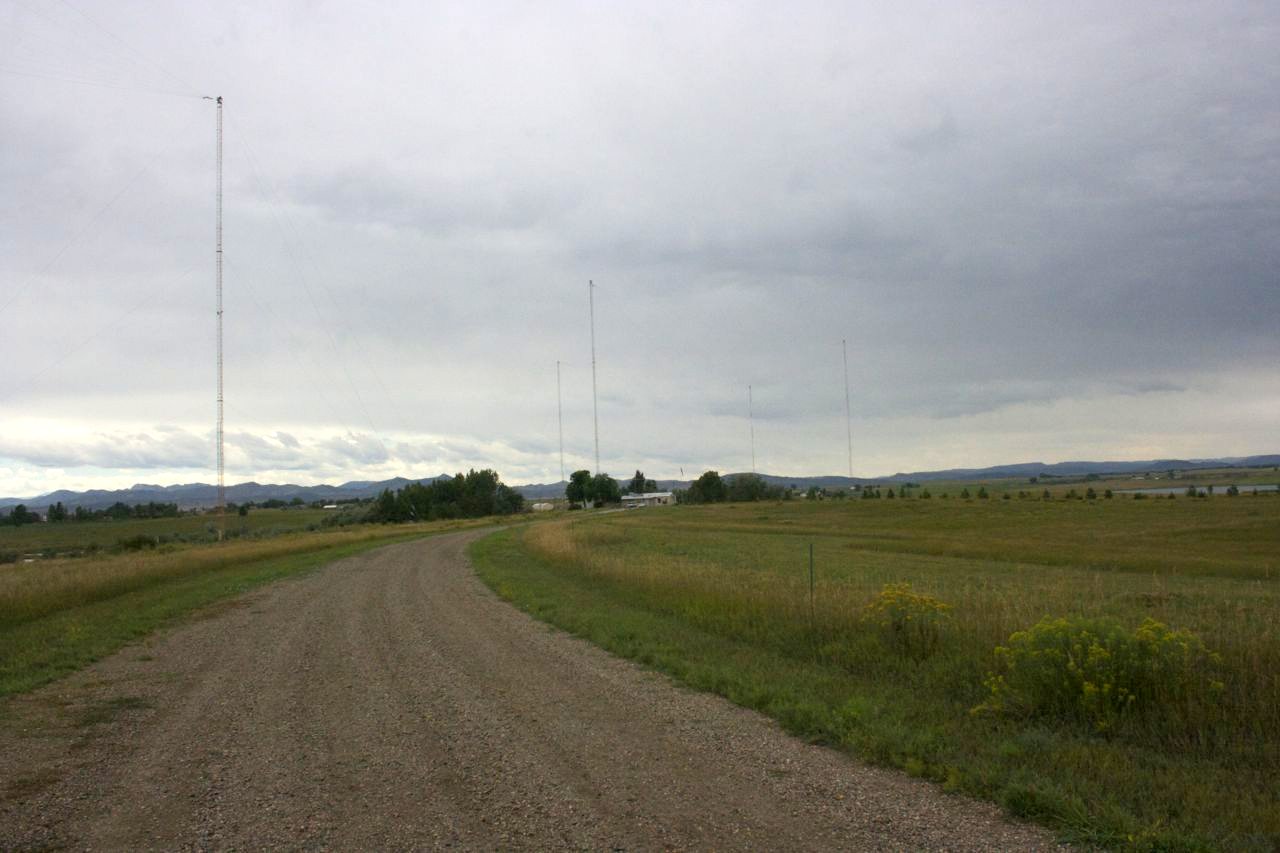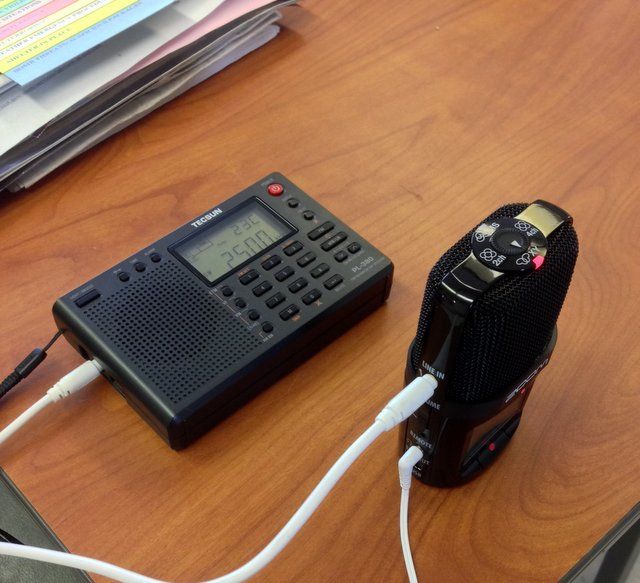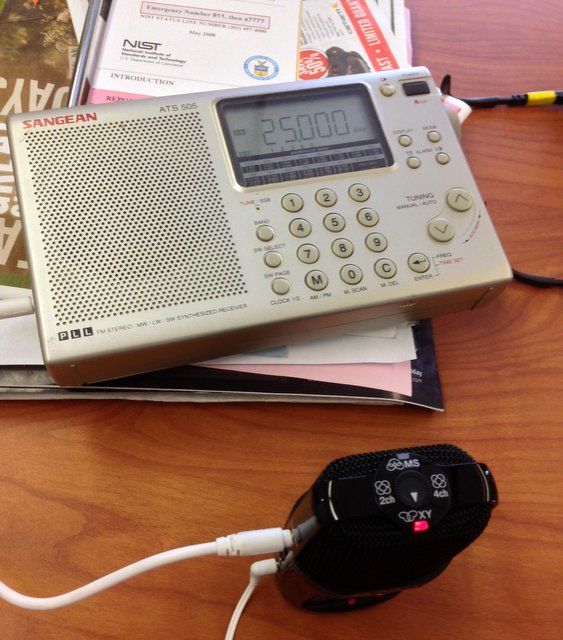 If you haven’t already guessed it: yes, the mystery broadcast site I posted on Thursday was WWV/WWVB in Fort Collins, Colorado. Well done, responders! Specifically, the photo shows the southern antennas of WWVB as I departed the site on Thursday, August 28, 2014; for those of you who got that detail, extra credit–!
If you haven’t already guessed it: yes, the mystery broadcast site I posted on Thursday was WWV/WWVB in Fort Collins, Colorado. Well done, responders! Specifically, the photo shows the southern antennas of WWVB as I departed the site on Thursday, August 28, 2014; for those of you who got that detail, extra credit–!
I’d like to thank the staff at WWV/WWVB for allowing me to visit the site for the better part of the day. WWV is not officially open to tours, so this was a particular honor for me. And this was an especially fun pilgrimage, as WWV was most likely the first shortwave broadcast I ever heard: as I’ve previously noted, when I was a kid my father used to set his watch to WWV every Sunday morning. Now I’ve seen firsthand where that famous tock, tock (and accompanying characteristic tones) originate.
When I return home from my extended travels, I’ll sort through the photos I took at WWV and WWVB, and post them here on the SWLing Post.
Recording WWV
In the meantime, I have a few recordings to share with those who are interested in this mecca of chronology. Before leaving WWV, I pulled out my Tecsun PL-380 and my Zoom H2N digital recorder, and recorded all the WWV broadcast frequencies. I captured their 2.5, 5, 10, 15, 20 and even their recently reactivated 25 MHz signals.
I made these recordings in the conference room at WWVB broadcast house. As you can imagine, it was simply not at all necessary to extend the telescopic antenna. In fact, the signal was so strong, you’ll hear a slight amount of distortion in the voice audio.
Below, you can listen to the recordings of each frequency via the embedded player (click on the title to download the audio). Enjoy!
WWV on 15 MHz (includes top of the hour station ID)
Up to this point, I used the Tecsun PL-380, but quickly realized that the ‘380 wouldn’t tune to 25 MHz. A quick look at the back of the radio revealed that the ‘380 only tunes up to 21.950 MHz (!). Believe it or not, I’d never noticed this limitation of the PL-380, likely since I rarely tune above 21 MHz for broadcast listening. Learn something new every day…But I couldn’t fail to complete my recordings.
So what did I do? I turned to Matthew Deutch, Chief Engineer at WWV and WWVB, who kindly allowed me to use their Sangean ATS-505 to make the final recording:
WWV on 25 MHz (includes Atlantic and Pacific weather)



Pingback: Off-Grid Computer Time Synchronization – Off-Grid Weather
I see I’m not the only one who listened to all of the recordings at the same time.
sometimes, i received the 15000, and only once the 1000 in brasília, brasil. i have the record.
I live in Seaside Oregon as I have one Clock out of several that pick up the week signal from WWV. I have Thee watches that did pick up the signal Lost. Do have a Tecsun Radio can pick up 10 ms week. What Can I do about this as at one time could pick WWV strong.on the Coast
You need a larger and/or more direct antenna.
Hi have a square box from Realistic TIME KUBE and works and receive the time on 5-10 and 15 mhz. It use9v battery and also can be use with a ac adapter. Have lost the manual and i want touse an adapter instead of the 9v battery. So i need an adapter and don’t know the voltage adapter needed.Its ver old receiver. A small box. Size 3×4 ” and abou 3 ” high.
Model:12-159
Serial:847A3471
David Odor
Thanks
It would, of course, need a 9 volt AC-DC adapter.
Long ago, some were made that had a 9V battery style snap connector on the end of the cord,
but if you find a “new” one of those today, it is Very Old stock.
Today’s adapters typically have a 5,5 X 2,1 mm or 5,0 X 2,5 mm DC power connector.
You would need to use a mating connector attached to a 9V snap,
or cut the cord and splice the wires to the snap.
In this case, the red wire has to be negative and the black positive
because you would be using the snap the wrong way round.
If you need help with this, find an experienced hobbyist (such as an amateur radio operator)
or an audio repair shop.
The matter of making the necessary connections is very simple
and should take no more than a few minutes to complete.
One Very Important consideration is that most new adapters are of the “switching” type.
Rather than using a transformer, these use a switch-mode circuit that is more energy-efficient
than a transformer, but it often produces a lot of “RF hash”,
making radio reception somewhere between difficult and impossible.
If you can, get an older adapter (often available for a dollar or two at thrift shops)
that has a transformer in it, easily indicated by its size and weight compared to a switcher —
the transformer type is usually a little larger and Much heavier.
David
KJ6QKV
I’ve always wanted to know if you ever had to worry about which way you pointed your clock if you lived in CO.. It’s a shame that they wont build a site on the east coast.
I know this is a “late” reply…
WWV started on the east coast: It was originally located in DC, then moved to Maryland.
Eventually it was moved to Colorado.
There is no need for more than one transmitter location on the North American continent.
If you can’t usefully receive it, you need a better antenna and/or a better radio.
For “radio controlled” clocks, the trick is locating them so that their internal antennas
are better able to pick up the 60 kHz signal.
Unfortunately they don’t include indicators to assist in the process.
What is happened to all or any of the time frequency’s to the coast of Oregon near Astoria that keep My time clocks on time? I turned on the short wave radio on today and scanned the band and none of the signals are active To indicate a time constant to keep most al My Clocks that require this service to stay on time.
I still have a problem with some of My time pieces to lock in on the coast in Oregon, i can get 10 in the back yard with the TECSUN RADIO not all the time.
I could not find the sight and nothing in Fort Collins phone book. We were passing through on holidays from Canada
Hi, Dwight,
Unfortunately, they are not open to the public, so you couldn’t have stopped by even if you had their number. Were you able to see the antenna farm from the road? I believe it can be seen from the highway.
Even their driveway is inconspicuous and not mentioned on any maps. In fact, Google Maps and/or Apple Maps sends you into a farm.
Cheers,
Thomas
Hi and thank you so much for the reply. I just wanted to take a picture by a sign. Oh well next trip !!
I also had the pleasure to do drive by several years ago but no luck with a tour
No problem picking up signals with my icom R 20
Nice to see the engineering team relying on a Sangean as their reference receiver
When I was at the Marconi museum near Cape Cod they had a Frg-7
Brief history and personal events with WWV. All NASA Satellite tracking stations syncronized timing with WWV, US NAVY STANDARD AND BCDT AGAINST START CHARTS AND .
later on Ruby Standards and The bureau has Cesium.
I was at Tracking station in Ecuador call sign HC1AGI (International Geophysical Year) right after SPUTNIK . Used a Mosley 3 Element three band beam, 1960
started Engineering and Ops Code 533 GOddard Space Flight Center…my lab and office about
s short walk to the low Hill where WWV Building sorrounded by the HIgh elegant Vertical antennas. Several LAbs with Faraday tight shielded tight…had troiuble keeping some residual
RF from some devices and measurements ( HP Spectrum Analizers had a 5 mhz I.F) and they
were all around GSFC….
Our GSFC WA3NAN was very large and active in all areas of research and development with
members of all trades and know how…As soon as WWV started to close we had requested the
useage of the entire site and faccilities, but ended up installing WA3NAN systens in trailers
and antennas on the wonderful POLES. WA3NAN (my call hc1ka/wa3fum) eventually was reassigned a site away
near to NASA GSFC till today.
I started SLWing..in Ecuador at the age of 11-12 adn already had found of course WWV on
all bands and helped people syncronize their clock devices. Great coincidences in the life
with RF and timing developments and thanks for the recordings which were part of a lifetime.
Have lots of photos and NASA events which were broadcasted from the HIGH POLES for
years conmemorating the space achievements from the unforgetable WWV Timing SIte.
73
T.Jaramillo hc5k/k4lrj ( retired in Ecuador hamming satellites )
Its a long time ago, that i tuned into the time signal channels. will try it next time with the remote controlled SDR at twente/ PA0.
mni tks for the vy gd recordings.
73
Juergen
DL4KE
nnnn
It’s so clear, it almost sounds fake. Thanks much for the recordings, looking forward to further report.
Which freq. is the one that keeps my atomic watch on time?
Hi, George,
It’s a 60 kHz signal that your clock receives via WWVB. Here’s an NIST article that explains:
http://www.nist.gov/pml/div688/grp40/radioclocks.cfm
Also, WikiPedia has an in-depth overview of WWVB:
http://en.wikipedia.org/wiki/WWVB
Cheers,
Thomas
What a “coincidence”. Hopefully, before the summer holidays officially end, I will be off to another shortwave transmitter site. Well, to the remains of it. I will be visiting the former RFE/RL (and VOA in the last years of operation) site in Playa de Pals, near the Catalan city of Girona and also very close to my main QTH in Barcelona. The Pals RFE/RL site was from where a 1MW signal was transmitted by feeding the same audio signal to 4 Continental transmitters. Their output signals where put in phase, then the big Group D dipole curtain was divided into two “halves” by switching the feed lines in the appropriate way. Each half of the curtain received 500KW from two transmitters. So the total was 1000KW, or 1MW. If we add the antenna gain, the ERP was in the order of several megawatts. This was a signal directed to Eastern Europe, and more specifically to Moscow, via single-hop propagation. I suppose receivers in Moscow released plenty of smoke and had to be replaced every time they were tuned to a RFE/RL signal from Pals. Hahaha!
The curtains were demolished in 2006 and because the place is abandoned now and has been repeatedly sacked, the station buildings are in a very poor situation, specially in the inside. Almost no radio hardware survives, but what is still there is quite interesting. For example, I am interested in one of the parabolic dishes (6.5m in diameter) that was used to receive the audio feeds via satellite (Those audio signals were the ones which were then rebroadcasted on shortwave frequencies). I wonder whether that dish could be used for ham radio microwave experimentation purposes. Here in Spain and more specifically in Catalonia the GHz bands are seeing every day more ham activity, so my idea could be good.
There is an excellent website (www.radioliberty.org) which is a virtual museum of all things related to the Pals station. It was created and is maintained by a former worker of the station. The language in the English version of the website is a bit “macaronic” in some parts of the site, but I think this is a minor issue given the excellent amount of information kept there.
There is also a YouTube channel (https://www.youtube.com/user/PalsRadioStation) which keeps videos for the above website. Some of them are really long and very complete.
Finally, although not part of the Pals station virtual museum website, there was even a documentary made, after the demolition of the antennas, as a tribute to the station. It can be watched in the following link although parts of it have not been translated to English: https://www.youtube.com/watch?v=tJnxsSL3bbY
I will be taking some receivers (and other radio materials, such as antennas) with me when I go there. If it was an excellent location for a shortwave broadcasting transmitter site, I suppose it will also be an excellent location for DXing in the same bands!
David – EA4998URE SWL
Hi Thomas
that good experience, hopefully you can share photos of the transmitters and antennas
good DX
Rafael R
I will, Rafael–as soon as I’m back home and have time top sort through all of the photos (300+)! It was a great experience–the staff at the stations were incredibly accommodating.
Cheers,
Thomas
bonjour merci pour vos infos toujours aussi intéressantes les une que les autres ;Amitiés depuis la france de lionel F14425SWL
toutes mes excuses pour écrire en français je ne parle pas en anglais THANKS pour vos infos
Lionel,
Je vous remercie pour votre commentaire. Je suis très heureux que vous écrivez en français; il y a un bon nombre de francophones qui lit le SWLing Post–donc pas de problème!
-Thomas